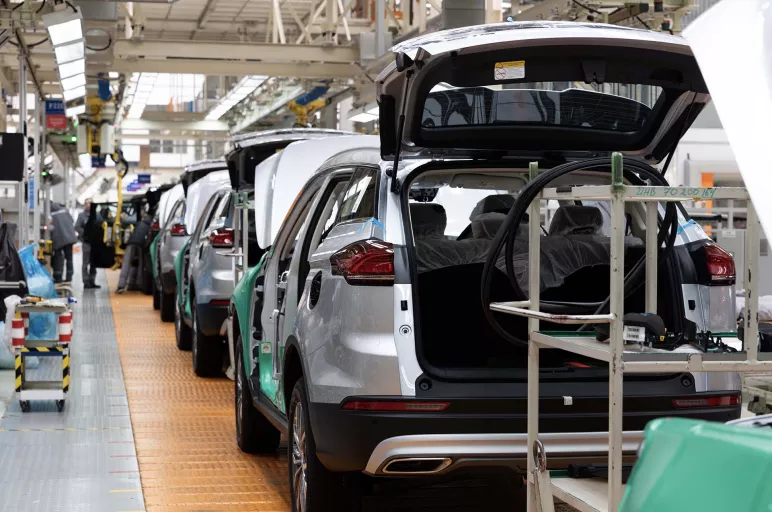
Graphite Shortage: Supply Chain Strategies for EV Makers
- Addressing graphite supply challenges after China’s export curbs requires innovative strategies from the automotive industry.
- Friendshoring, alternative sourcing and agile procurement can be key approaches for supply chain resilience.
- Data analytics and anode material innovation too can be vital to mitigating supply chain disruptions.
November 02, 2023 | Automotives 4 minutes read
China's recent decision to impose export controls on graphite products has raised alarm bells within the global electric vehicle industry, since graphite is a vital component in EV battery anodes.
China is the world's leading supplier of graphite and given the increasing demand for EVs and the subsequent reliance on graphite, procurement teams in automobile companies are worried about graphite supply chain stability and potential cost implications. They now face the challenge of securing alternative sources to meet their production needs.
A Skewed Graphite Supply Chain
China refines nearly 90% of the world's graphite, which is an essential material for nearly all EV battery anodes. Last year, it produced 79% of the world's graphite supply, while North America contributed just 1.2%.
The curbs on graphite export is also significant due to the expected supply shortage of graphite for EV batteries. It’s estimated that the graphite shortfall will grow considerably over the next decade. The limited number of graphite mines globally leaves manufacturers depend upon a handful of sources, making them vulnerable to supply disruptions.
So, how should the automotive industry’s supply chain and procurement leaders navigate graphite’s tight supply situation?
Strategies for Procurement Teams to Mitigate Risks
Secure Long-Term Contracts
Locking in graphite pricing and volume through long-term (5+ year) contracts is crucial. Even if at a premium cost, this reduces volatility risk. Procurement should negotiate supplier agreements strategically ahead of projected shortages.
Friendshoring
This means moving supply chains to jurisdictions that do not pose serious geopolitical risks. For the U.S., China is also not the only source. Mexico, Canada and India are other large exporters of graphite to the U.S.
For instance, Tesla struck a deal with Syrah Resources to buy graphite from Mozambique, reducing reliance on China. Northern Graphite, operating in Quebec, is opening a second mine in Bissett Creek to meet growing demand.
Invest in Graphite Recycling and Reuse
Procurement teams should explore the possibilities of recycling and reusing graphite from end-of-life batteries, as well as from scrap and waste materials from battery production. This would reduce the dependence on primary graphite and lower the environmental impact of battery manufacturing and disposal.
Technology and Data Utilization
Modern supply chains leverage AI technology and data analytics to become more agile. Real-time data and advanced analytics provide insights into market trends, supplier performance, and potential disruptions. With this information, companies can make informed decisions to adapt to market changes effectively.
For instance, technology and data analytics can help closely monitor inventory levels, assessing real-time demand and utilizing predictive analytics, companies can optimize their stock levels. This ensures they have sufficient graphite to meet market demands without accumulating excess inventory, which can incur storage expenses and depreciation costs.
Stockpile and Strategic Reserves
Creating strategic reserves of graphite can be another approach for companies to safeguard against potential supply disruptions. While establishing such reserves involves an initial capital investment for procuring and storing graphite, these insulate automakers against short-term supply challenges and provide price stability.
Research on Alternatives
Another crucial anode component is silicon, known for extending an electric vehicle's (EV) driving range before needing a recharge. Batteries can typically accommodate up to about 10% silicon because the material expands during use, potentially harming battery performance. Nevertheless, companies are actively striving to increase this proportion.
Also, new investments in the U.S. and Europe can reduce dependence on China for graphite by developing synthetic graphite. Vianode, an Norway-based synthetic graphite startup, is starting small-scale production, ramping up to full scale in Europe and the U.S. by 2030.
Agile Procurement Strategies
The ability to adapt to changing circumstances in China’s market is crucial for maintaining supply chain resilience. Implementing agile and flexible procurement strategies can help in quickly responding to market changes and ensuring uninterrupted supply flow. It can also help choose the best alternative raw materials and suppliers, rerouting shipments, or revising procurement strategies to mitigate losses.
Build Strong Relationships with Suppliers
Nurturing strong supplier relationships is invaluable during material shortages, offering priority access to resources, flexible negotiations, and collaborative problem-solving. Trusted suppliers are more likely to prioritize reliable partners, reducing the risk of production disruptions and providing preferential treatment. These relationships also lead to long-term strategic benefits, including innovation and sustainability initiatives.
To Sum Up
While no single approach addresses the complex graphite supply dilemma, combining different mitigation strategies provides a robust action plan.
The time to act is now — delaying graphite shortage preparations could leave EV parts suppliers in a precarious situation. Through cross-functional collaboration and procurement leadership, battery makers can navigate the graphite supply challenges in the years ahead.



